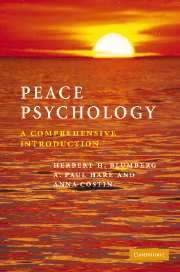Book contents
- Frontmatter
- Contents
- Preface
- Acknowledgements
- The scope, structure and content of this book
- Part I Introduction
- Part II Interdisciplinary practice
- Part III Primary psychological topics
- Part IV Core topics in peace and environmental studies
- Part V Terrorism
- 15 Terrorist threats
- 16 Victims of terrorism
- References
- Index
16 - Victims of terrorism
Published online by Cambridge University Press: 05 June 2012
- Frontmatter
- Contents
- Preface
- Acknowledgements
- The scope, structure and content of this book
- Part I Introduction
- Part II Interdisciplinary practice
- Part III Primary psychological topics
- Part IV Core topics in peace and environmental studies
- Part V Terrorism
- 15 Terrorist threats
- 16 Victims of terrorism
- References
- Index
Summary
When discussing the victims of terrorism, it is essential to bear in mind the important distinction between single acts of terrorism, and on-going campaigns. It can be difficult to define terrorist attacks in situations of protracted political violence – such as that in Northern Ireland, Israel–Palestine and Sri Lanka. Protracted political violence tends to be characterized by highly variable degrees of violence. Acts of terrorism within that conflict tend to become part of daily life, abhorred by society at large, but not unexpected.
Isolated acts of terrorism – which can be linked to on-going conflict, such as the IRA's campaign on the British mainland in the 1980s and 1990s – tend to be high-impact incidents with high casualties. Browne (2003) writes that psychological reactions to on-going terrorism are not unlike reactions to war. Summerfield (1996) states that many modern conflicts are a combination of both warfare and terrorism. Exposure to acute trauma is followed by distress symptoms and a period of adjustment then a return to normality. That is not to say that isolated attacks have better outcomes. Such exposure can lead to high levels of post-traumatic stress symptoms, whereas on-going terrorism can lead to adaptive coping.
Disaster studies classify victims into direct (physically present or in close proximity to an event), secondary (family members and close friends of victims and professionals who assist them such as emergency personnel) and indirect (individuals in a community affected by the secondary effects).
- Type
- Chapter
- Information
- Peace PsychologyA Comprehensive Introduction, pp. 234 - 245Publisher: Cambridge University PressPrint publication year: 2006

